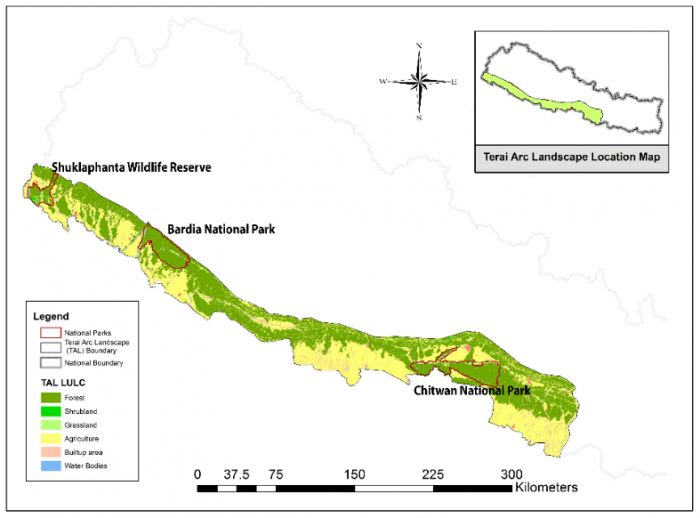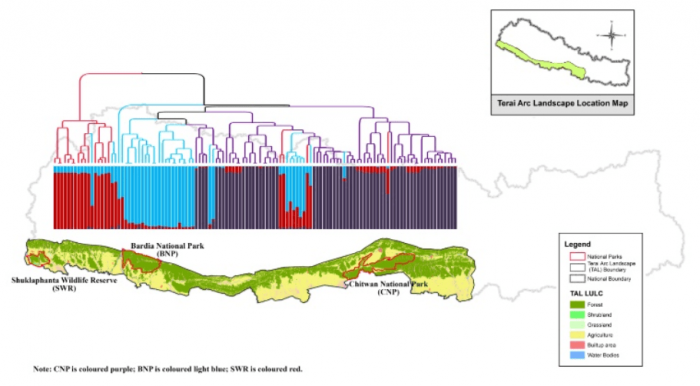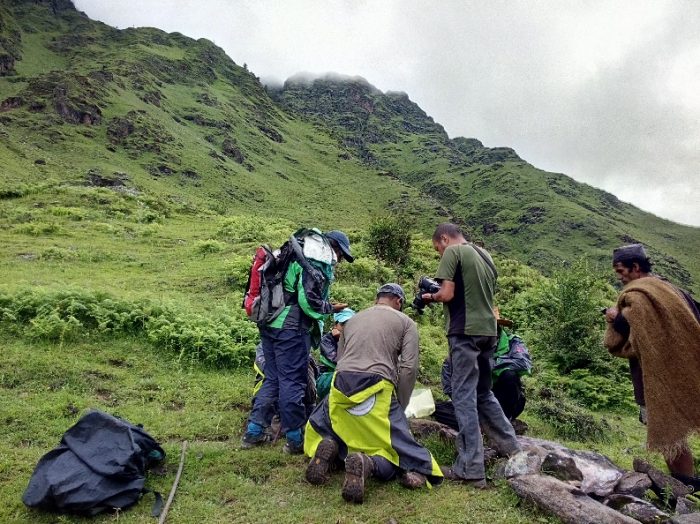
In the Indian subcontinent, Bengal tigers inhabit tropical grassland, riverine, and moist semi-deciduous forests along major river systems. The tiger population in the southern belt of Nepal, often called Terai, is split into three isolated subpopulations that are fragmented by agricultural land and densely-settled human habitats. The largest population lives in the Chitwan National Park and in the adjacent Parsa Wildlife Reserve, encompassing an area of 2,543 km2 (982 sq. mi) of prime lowland forest. To the west, Bardia National Park and the Shuklaphanta Wildlife Reserve hold the other two tiger subpopulations, well separated from the Chitwan population by one of the growing towns of Butwal.

Figure republished with permission from PLOS One from https://doi.org/10.1371/journal.pone.0221868
Of the total estimated 3000 Bengal tigers in the Indian subcontinent, Nepal has a little over 200 tigers, with the Chitwan National Park carrying around 125, Bardia National Park around 50, and Suklaphanta 25. Although recent surveys have indicated a gradual increase in the tiger population, some major concerns remain regarding their future survivability.
Over the past century, the tiger population has dwindled, and their habitat has reduced drastically. As it stands, there is a greater realization that none of the current tiger conservation areas, protected or otherwise, are large enough to hold an effective population size of 250 individuals or more. Habitat loss and high incidences of poaching are serious threats to tigers’ survival.
Tigers are rapidly losing their habitat
There has been a dramatic decline in forest cover and an increase in agricultural land. In the last 300 years, 62% of the forest in the Terai plains of Nepal have been turned into agricultural fields, with rapid conversion occurring between the 19th and 20th centuries. A large-scale human resettlement west of the Chitwan National Park in the first half of the 19th century probably was responsible for fragmenting the tiger population into two subpopulations. And the threat of further degradation of this tiger habitat remains due to rapid human population growth in the lowlands of Nepal.
Tiger parts are in great demand: Poaching has been a big problem
There is a growing demand for tiger body parts such as skin and bones in countries like China, where they are often widely used as ingredients in traditional medicine. This has increased tiger poaching in all the tiger ranging countries in South Asia, including Nepal. There is often inadequate enforcement response in these countries to stop or slow down wildlife crime (poaching). According to a report from the Wildlife Protection Society of India, in 15 years (1994-2009) there were more than 893 documented cases of tiger killings in India, which experts believe is just a fraction of the actual total poaching.
Human-tiger conflict increasing
The increasing human population is encroaching and shrinking tiger habitats, thereby increasing the risks of human-tiger conflict. The conflict often results in human, tiger, or livestock losses. There were no recorded cases of human death due to tiger attacks before 1980 in Chitwan National Park. However, the following year, 13 people were killed in tiger attacks. Every year there are reported cases of human and livestock casualties in Nepal, and the government is struggling with mitigation and compensation challenges with human-wildlife conflicts. This creates resentment in the affected communities, and often this results in the retaliatory killing of animals.
More information on tigers needed: Novel DNA technology is helping
Our effort has been to utilize novel DNA-based technologies to have a broader landscape-level of understanding of tiger conservation and to develop effective policies and strategies for the species. Genetic analysis has become an effective and popular method and is used in all aspects of wildlife biology and conservation. Since portions of the genome of every individual are unique, the use of genetic tools yields highly specific information that can help in estimating animal migration rates, population size, bottlenecks, and kinship. Genetic analysis can also be utilized to identify species, sex, and individuals, as well as provide insight into its population trend and to gather other taxonomic level information.
Since it is infeasible to enumerate populations of low density, wide-ranging, and elusive species like tigers, non-invasive methods of detecting the species by using scat or fecal samples have been frequently employed to infer estimations on the number of individuals in a certain area; moreover, this method has also been favored for eliminating the need for direct interactions (invasive) that could potentially have adverse effects on animal welfare.
Information obtained using DNA has been able to answer some of the outstanding tiger conservation-related questions: How many tigers are there in each of the national parks? How healthy are they from a genetic perspective? Are there any interactions between pockets of tiger populations? Will we be able to track the source of poached tiger parts and help in the fight against wildlife crime?

Figure republished with permission from PLOS One from https://doi.org/10.1371/journal.pone.0221868
Having a geospatial genetic database of all the wild tigers in Nepal means a long term monitoring and status assessment can be done. In essence, that is what we have achieved through the Nepal Tiger Genome Project.
Tiger gut microbiota: Unravelling tigers’ interactions and health
Wildlife diseases might be the next big challenge to tiger conservation. As tiger habitats are gradually being encroached by humans and livestock, there is a growing threat of zoonotic diseases being transmitted between humans, animals (livestock), and wildlife populations. Microbiota is closely linked to health, and, hence, microbial phylogenies can be used as signatures of disease transmission and has the potential for monitoring population health, density, movement, and dispersal. We conducted one of the largest microbiota surveys of a wild carnivore, spanning three populations with different degrees of connectivity and human visitation.

Figure republished with permission from PLOS One from https://doi.org/10.1371/journal.pone.0221868
We studied the gut microbiota in 32 individual tigers from three geographically separated areas in Nepal. Gut microbiota influence the immune system, impact various physiological functions, and modulates metabolic reactions that ultimately impact the host health, behavior and development.
Across the tiger populations in Nepal, we found significant differences in the composition of microbial communities based on their geographic locations. Specifically, we detected significant differences between Chitwan National Park and the other two protected areas, but no differences between the other two in the western part. We conclude the tiger population structure, gut microbiota profile, and associated functional metabolic categories are correlated.
More tiger secrets using poop
Using the latest in genomics and next-generation sequencing, our center is assessing the diet of tigers based on a meta-barcoding technique. Building the ecological pyramid of apex predators like the tiger will help us understand the health of biodiversity. Uncovering all these mysteries of nature will perhaps help us preserve it better.
Good science through global partnership
The Center for Molecular Dynamics Nepal is a biodiversity and disease research institute based in Kathmandu, Nepal. Over the years, the center has collaborated with many institutions and researchers from around the globe. Conservation in general and conservation research in particular greatly benefits from the free exchange of ideas and collaboration. The Nepal Tiger Genome Project was successful in generating ideas, excitement, and outputs because it had wider global participation. Finding out more about the tiger can help us understand our nature, and, working together, we can conserve it.









